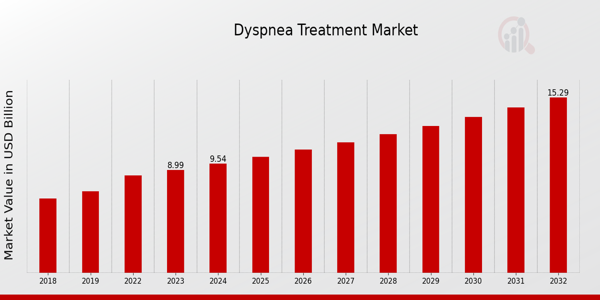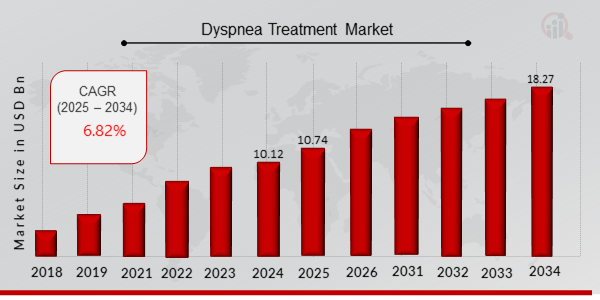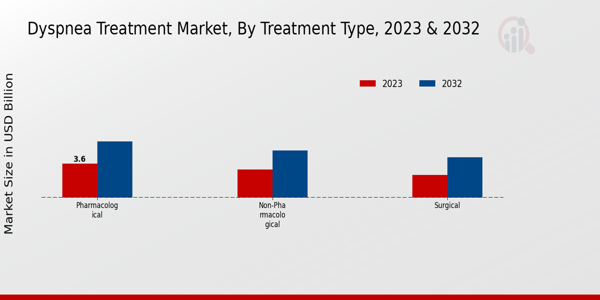Dyspnea Treatment Market Overview
As per MRFR analysis, the Dyspnea Treatment Market Size was estimated at 10.12 (USD Billion) in 2024. The Dyspnea Treatment Market Industry is expected to grow from 10.74 (USD Billion) in 2025 to 18.27 (USD Billion) till 2034, at a CAGR (growth rate) is expected to be around 6.08% during the forecast period (2025 - 2034).
Key Dyspnea Treatment Market Trends Highlighted
The Dyspnea Treatment Market is driven by several key factors that elevate the demand for effective therapies. An aging population increases the prevalence of chronic respiratory diseases, such as asthma and COPD, which significantly contribute to dyspnea. Advances in medical technologies also support innovative treatment options, ranging from pharmacological interventions to advanced respiratory devices, thereby enhancing patient outcomes. Moreover, heightened awareness of respiratory health among patients and healthcare providers has led to improved diagnosis and management options, driving market growth. As opportunities arise, there is potential for expansion in tailored treatment approaches that take into account individual patient needs.The integration of telemedicine in managing chronic respiratory conditions is a growing trend that provides patients with access to care from home, improving their quality of life. Additionally, there is a rising interest in developing novel therapies, including biologics and targeted treatments. Global health initiatives promoting better respiratory care can further foster market growth by enhancing access to treatments for underserved populations, particularly in low and middle-income countries. Recently, trends in the dyspnea treatment landscape reflect a shift towards personalized medicine, with a focus on genetic and environmental factors that affect treatment efficacy.There is also increasing interest in preventive strategies aimed at reducing the incidence of conditions leading to dyspnea. Collaborative efforts among stakeholders, including pharmaceutical companies, healthcare providers, and regulatory bodies, are vital in maximizing the potential of the dyspnea treatment market. Overall, the combination of technological advancement and an expanding patient base creates a dynamic environment rich with opportunities for growth and improvement in dyspnea management.

 ondary Research, MRFR Database and Analyst Review
ondary Research, MRFR Database and Analyst Review
Dyspnea Treatment Market Drivers
Increasing Prevalence of Respiratory Diseases
The rising occurrence of respiratory diseases, particularly chronic obstructive pulmonary disease (COPD), asthma, and interstitial lung disease, is a significant driver of growth in the Dyspnea Treatment Market Industry. As the global population is gradually becoming older and steadily urbanizing, respiratory diseases are steadily becoming prevalent. Such diseases place a heavy burden on an already overstrained healthcare provision in many countries. Patients with these illnesses suffer increased episodes of dyspnea, which can be distressing and greatly reduce the overall quality of life; thus, effective alternatives must be availed.
Consequently, both healthcare companies and pharmaceutical organizations are increasingly concerned with the design and construction of novel drugs and therapies that can also be effective in doling out dyspnea management for better overall patient outcomes. Furthermore, the implementation of awareness and educational campaigns regarding the diagnosis and management of these respiratory conditions should result in more patients seeking help, which will, in turn, encourage market development. The focus on R&D to find new treatment modalities and collaborative practices such as telehealth and digital health as part of therapy is expected to improve patient treatment and spur further growth in the Dyspnea Treatment Market Industry.
Technological Advancements in Treatment Options
The advancement of technology in the medical field is transforming the landscape of the Dyspnea Treatment Market Industry. Innovations in drug delivery systems, such as inhalers and nebulizers, are improving the efficiency and effectiveness of treatments for patients experiencing dyspnea. Furthermore, the development of targeted therapies and biologics is expanding the range of available treatment options. As these technologies evolve, they offer more personalized approaches to managing respiratory symptoms, catering to the specific needs of individual patients.This not only enhances treatment efficacy but also boosts patient compliance and satisfaction, ultimately contributing to market expansion.
Growing Investment in Healthcare Infrastructure
The global increase in healthcare spending and investment in healthcare infrastructure is playing a pivotal role in the growth of the Dyspnea Treatment Market Industry. Governments and private entities are recognizing the importance of improved healthcare facilities and services, particularly in managing chronic diseases like respiratory conditions. Enhanced access to healthcare services allows for early detection and intervention of diseases leading to dyspnea, enabling timely treatment.Additionally, the establishment of specialized respiratory care centers is likely to increase patient access to dyspnea treatment options. As the healthcare infrastructure continues to develop, improved treatment accessibility and availability are expected to support the growth of the market.
Dyspnea Treatment Market Segment Insights
Dyspnea Treatment Market Treatment Type Insights
The Dyspnea Treatment Market exhibits a robust expansion trajectory, particularly within the Treatment Type segment, which encompasses Pharmacological, Non-Pharmacological, and Surgical interventions. In 2023, the overall market valuation reached 8.99 USD Billion, showing significant growth potential as it is projected to increase to 15.3 USD Billion by 2032, reflecting the rising demand for effective dyspnea management solutions. Within this market, Pharmacological treatments, valued at 3.6 USD Billion in 2023 and expected to grow to 6.0 USD Billion by 2032, hold a majority position, highlighting their critical role in addressing the symptoms of respiratory distress through medications such as bronchodilators and corticosteroids.Non-Pharmacological approaches, on the other hand, accounted for 3.0 USD Billion in 2023 and are anticipated to reach 5.0 USD Billion by 2032, emphasizing their importance in holistic patient care, including pulmonary rehabilitation and oxygen therapy, which significantly enhances the quality of life for patients. Surgical interventions represented a valued segment of 2.39 USD Billion in 2023 with an expectation to grow to 4.3 USD Billion by 2032, demonstrating their specialized yet essential role in severe cases where other treatments may not suffice, particularly in the context of lung transplantation or surgical correction of structural abnormalities affecting respiration.The significant increase in these market valuations showcases a growing awareness of and investment in targeted treatments for dyspnea, reflecting major trends influenced by an aging population, rising prevalence of chronic respiratory diseases, and advancements in medical technology. These dynamics present a myriad of opportunities for stakeholders across the Dyspnea Treatment Market industry as they navigate the challenges inherent to developing effective solutions while addressing healthcare access disparities. The ongoing research and innovation within pharmacological and non-pharmacological domains, alongside the surgical segment's advancements, affirm the critical importance of tailored interventions in meeting the diverse needs of patients suffering from dyspnea.

Source: Primary Research, Secondary Research, MRFR Database and Analyst Review
Dyspnea Treatment Market Administration Route Insights
The Administration Route segment of the Dyspnea Treatment Market plays a crucial role in the effective delivery of therapies to patients experiencing breathing difficulties. In 2023, the market valuation stands at 8.99 USD Billion, with a steady trajectory expected to reach 15.3 USD Billion by 2032. This segment is categorized into diverse methods including Oral, Inhalation, Intravenous, and Subcutaneous routes, each holding its unique significance. The Inhalation route is particularly noteworthy as it allows for targeted delivery of medication directly to the lungs, enhancing therapeutic efficacy for conditions like asthma and COPD.Furthermore, Oral administration remains widely preferred due to its ease of use and patient compliance, making it a dominant choice among treatments. The Intravenous and Subcutaneous methods, while less common, are critical for rapidly addressing acute dyspnea situations or ensuring sustained medication delivery. Trends such as the growing prevalence of respiratory diseases and advancements in drug formulations are key growth drivers, while challenges include ensuring patient adherence and managing side effects. The Dyspnea Treatment Market data highlights significant opportunities for innovation within the Administration Route, fostering a more tailored approach to patient care in respiratory health.
Dyspnea Treatment Market Disease Type Insights
The Dyspnea Treatment Market, valued at 8.99 USD Billion in 2023, showcases a growing landscape influenced by various disease types. Chronic Obstructive Pulmonary Disease (COPD) plays a pivotal role, as it is one of the leading causes of dyspnea, driving significant market demand and treatment innovations. Asthma also holds a considerable share as its prevalence continues to rise, highlighting a critical area for therapeutic development. Interstitial Lung Disease significantly contributes to the market, given its complex nature and requirement for specialized treatments.Additionally, Pulmonary Hypertension, although less widespread, remains a crucial segment due to its severe implications and the necessity for targeted therapies. The evolving nature of these diseases, coupled with increasing awareness and advancements in treatment options, is setting a foundation for robust market growth and presents considerable opportunities for stakeholders in the Dyspnea Treatment Market industry, paving the way for improved patient outcomes. Emerging trends and ongoing research in these areas will further enhance the Dyspnea Treatment Market data and statistics, signifying a dynamic and responsive market landscape.
Dyspnea Treatment Market Patient Type Insights
The Dyspnea Treatment Market has shown substantive growth, with significant revenue expected as the treatment landscape evolves for various patient types. In 2023, the market was valued at 8.99 billion USD, reflecting the urgent need for effective dyspnea interventions across different demographics. The segmentation into Adults, Pediatrics, and Geriatrics highlights the tailored approaches required for effective management of dyspnea in various populations. Adults represent a significant portion of the market, primarily due to the higher prevalence of chronic respiratory diseases.Meanwhile, the Pediatrics segment is crucial, as untreated dyspnea can lead to serious health complications in children, making timely interventions essential. Geriatrics also dominate the market, driven by the increasing elderly population and associated respiratory issues, requiring specialized treatment solutions. Current trends reveal a focus on personalized healthcare options, which enhance the market growth potential. Challenges such as access to treatments and healthcare disparities persist, creating both hurdles and opportunities for innovation in the Dyspnea Treatment Market.Enhanced understanding of patient-specific needs and ongoing advancements in therapies are likely to shape the future landscape of this critical healthcare segment.
Dyspnea Treatment Market Regional Insights
The Dyspnea Treatment Market revenue in 2023 was valued at 8.99 USD Billion, with a robust projected increase in the coming years. Within the Regional market segmentation, North America emerged as a dominant player, accounting for 3.5 USD Billion in 2023 and expected to rise to 5.9 USD Billion by 2032, indicating a majority holding in the overall market due to advanced healthcare infrastructure and a high prevalence of respiratory diseases. Europe followed as a significant contributor with a valuation of 2.7 USD Billion in 2023, anticipated to grow to 4.6 USD Billion by 2032, supported by increasing regulatory approvals for dyspnea treatments.APAC, valued at 1.9 USD Billion in 2023, is projected to reach 3.5 USD Billion by 2032, reflecting a growing awareness of respiratory health and rising investments in healthcare. South America and MEA, while smaller in scale with valuations of 0.6 USD Billion and 0.29 USD Billion, respectively, in 2023, present opportunities for expansion, particularly through increasing healthcare access and improved public health policies. The Dyspnea Treatment Market statistics highlight notable growth drivers, such as an aging population and environmental factors, marking a trend toward steady market growth.

Source: Primary Research, Secondary Research, MRFR Database and Analyst Review
Dyspnea Treatment Market Key Players and Competitive Insights
The Dyspnea Treatment Market is characterized by a dynamic and competitive landscape, primarily driven by an increasing prevalence of respiratory disorders and a growing aging population. Companies operating within this market continuously innovate to develop effective treatment options, targeting the underlying causes of dyspnea, such as asthma, chronic obstructive pulmonary disease, and other respiratory ailments. The market environment is marked by strategic collaborations, acquisitions, and advancements in drug formulations, with leading pharmaceutical companies striving to expand their portfolios of respiratory therapies. Additionally, rigorous clinical trials and regulatory approvals play a crucial role in determining the success of products in this market, necessitating companies to stay ahead in terms of research and development capabilities to fulfill unmet medical needs and enhance patient outcomes.Pfizer has established a significant presence in the Dyspnea Treatment Market, leveraging its extensive research capabilities and a robust pipeline of respiratory therapies. The company is known for its strong focus on innovation, which allows it to introduce novel treatments that address various respiratory conditions effectively. Pfizer's partnerships and collaborations with various healthcare stakeholders enhance its market position by facilitating the development and distribution of its products globally. Furthermore, its strategic investments in clinical trials aim to validate the efficacy of its treatments, building trust among healthcare providers and patients alike. The company’s commitment to improving patient access to effective therapies also contributes to its strength in the dyspnea treatment sector, allowing it to gain a competitive edge in a rapidly evolving market.Mylan is another key player in the Dyspnea Treatment Market, recognized for its broad portfolio of generic and specialty medications that cater to respiratory conditions. The company’s extensive experience in developing affordable alternatives makes it a critical contributor to increasing access to dyspnea treatment options for patients worldwide. Mylan’s strength lies in its deep distribution networks and strategic partnerships that enable it to reach diverse healthcare markets effectively. Moreover, the company's focus on expanding its respiratory franchise through innovative product launches enhances its competitiveness in the sector. By continuously evaluating market trends and patient needs, Mylan is poised to adapt its offerings accordingly, ensuring it remains relevant in the dyspnea treatment landscape while further reinforcing its market position through quality and cost-effective solutions.
Key Companies in the Dyspnea Treatment Market Include
- Pfizer
- Mylan
- Merck
- Eli Lilly
- AbbVie
- Teva Pharmaceutical Industries
- Roche
- GlaxoSmithKline
- Johnson and Johnson
- Boehringer Ingelheim
- AstraZeneca
- Novartis
- BristolMyers Squibb
- Gilead Sciences
- Sanofi
Dyspnea Treatment Market Industry Developments
Recent developments in the Dyspnea Treatment Market have been marked by significant advancements and collaborations among leading pharmaceutical companies. Pfizer and Merck have recently announced their efforts in expanding therapeutic options for chronic obstructive pulmonary disease (COPD) and asthma, conditions commonly associated with dyspnea. Meanwhile, AstraZeneca has made strides in its dual-action inhalation therapies aimed at alleviating symptoms for patients. In a recent growth trend, Eli Lilly and Novartis have also reported increased market valuations spurred by innovative research and enhanced treatment regimens that cater to patient needs. Regarding mergers and acquisitions, Boehringer Ingelheim has been actively pursuing partnerships to enhance its portfolio in respiratory disorders, which is likely to influence market penetration strategies. Additionally, the focus on patient-centered care continues to drive collaboration among companies like AbbVie and Roche, aimed at improving treatment adherence and outcomes. The increase in investment from these firms reflects a broader recognition of the urgent need for effective dyspnea management, fostering competitive dynamics within the market. Johnson & Johnson and Gilead Sciences are also exploring new avenues for growth, contributing to a robust market environment dedicated to respiratory health improvement.
Dyspnea Treatment Market Segmentation Insights
Dyspnea Treatment Market Treatment Type Outlook
- Pharmacological
- Non-Pharmacological
- Surgical
Dyspnea Treatment Market Administration Route Outlook
- Oral
- Inhalation
- Intravenous
- Subcutaneous
Dyspnea Treatment Market Disease Type Outlook
Dyspnea Treatment Market Patient Type Outlook
- Adults
- Pediatrics
- Geriatrics
Dyspnea Treatment Market Regional Outlook
- North America
- Europe
- South America
- Asia Pacific
- Middle East and Africa
| Report Attribute/Metric |
Details |
|
Market Size 2024
|
10.12 (USD Billion)
|
|
Market Size 2025
|
10.74 (USD Billion)
|
|
Market Size 2034
|
18.27 (USD Billion)
|
|
Compound Annual Growth Rate (CAGR)
|
6.08 % (2025 - 2034)
|
|
Report Coverage
|
Revenue Forecast, Competitive Landscape, Growth Factors, and Trends
|
|
Base Year
|
2024
|
|
Market Forecast Period
|
2025 - 2034
|
|
Historical Data
|
2020 - 2024
|
| Market Forecast Units |
USD Billion |
| Key Companies Profiled |
Pfizer, Mylan, Merck, Eli Lilly, AbbVie, Teva Pharmaceutical Industries, Roche, GlaxoSmithKline, Johnson and Johnson, Boehringer Ingelheim, AstraZeneca, Novartis, BristolMyers Squibb, Gilead Sciences, Sanofi |
| Segments Covered |
Treatment Type, Administration Route, Disease Type, Patient Type, Regional |
| Key Market Opportunities |
Increasing prevalence of respiratory diseases, Advancements in treatment technologies, Growing geriatric population, Rising awareness of treatment options, and Expansion of telemedicine services. |
| Key Market Dynamics |
rising prevalence of respiratory diseases, increasing aging population, advancements in treatment technologies, growing awareness of dyspnea, increasing healthcare expenditure |
| Countries Covered |
North America, Europe, APAC, South America, MEA |
Frequently Asked Questions (FAQ) :
The Dyspnea Treatment Market is expected to be valued at 18.27 USD Billion by 2034.
The expected CAGR for the Dyspnea Treatment Market from 2025 to 2034 is 6.08%.
North America is projected to have the largest market share with a valuation of 5.9 USD Billion by 2032.
The Pharmacological treatment type is expected to reach a market value of 6.0 USD Billion by 2032.
Major players in the Dyspnea Treatment Market include Pfizer, Merck, and Roche, among others.
The Non-Pharmacological treatment market is expected to be valued at 5.0 USD Billion by 2032.
The Surgical treatment type is expected to reach a market value of 4.3 USD Billion by 2032.
The APAC region is expected to reach a market size of 3.5 USD Billion by 2032.
Current challenges include regulatory hurdles and rising treatment costs impacting the Dyspnea Treatment Market.
The South American region is projected to have a market value of 1.1 USD Billion by 2032.







 ondary Research, MRFR Database and Analyst Review
ondary Research, MRFR Database and Analyst Review









